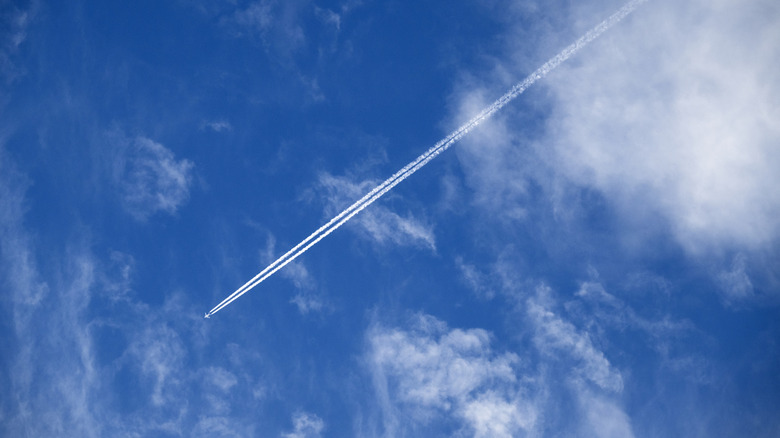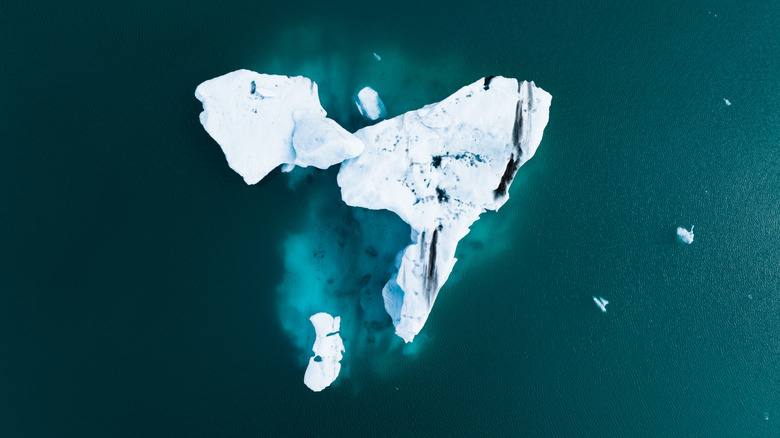What Those Trails Behind Planes Really Are And What Causes Them
If you've ever stared up at the sky and wondered about the long, white streaks emerging behind airplanes, you're definitely not alone. These ghostly lines are called contrails, short for condensation trails, and they're not smoke, pollution, or poison (despite what any number of popular YouTubers might claim). In fact, they're mostly ice. When jet engines burn fuel, one of the byproducts they emit is water vapor, which comes out in their exhaust. At cruising altitudes (usually around 25,000 to 40,000 feet up), that hot vapor hits frigid air and condenses rapidly into tiny water droplets, which then freeze almost instantly, forming a visible trail of ice crystals.
Whether or not a plane leaves a contrail depends on a few key atmospheric ingredients, mainly temperature, altitude, and humidity. In dry air, the vapor may dissipate before a trail can form. In moist, cold air, the vapor lingers and crystallizes, sometimes producing a thick, cloud-like trail that can stretch for miles. That's why you might spot two planes flying at different altitudes, one leaving a dramatic trail and the other appearing to produce nothing; the conditions around them aren't the same.
Contrails usually disappear within minutes, but under the right conditions, they can hang around and spread out. When they do, they can resemble high-altitude clouds and even affect weather and climate patterns by trapping heat in the atmosphere (yes, really). First, let's explore why these trails form, what they can tell us about the sky (including their connection to the difference between rain clouds and snow clouds), and why the chemtrails conspiracy is just that.
How contrails actually form (and why some stick around)
Contrails are a visible sign of physics at work. When jet fuel combusts, it releases carbon dioxide, water vapor, and trace gases. That water vapor mixes with the already cold, low-pressure atmosphere, often around -40 degrees Fahrenheit or colder, and rapidly condenses. In the split second after exiting the engines, that vapor freezes into ice crystals, forming what we see as a contrail. Think of it as a sky-high version of seeing your breath on a cold day, just with engines and far colder air. The lifespan of a contrail depends on the humidity and wind conditions at altitude. Dry air will lead to a brief appearance. Humid air, on the other hand, can lead to long-lasting contrails that spread into something that looks like a cirrus cloud.
These long-lasting contrails aren't a quirk; scientists are studying them because of their potential to trap heat and subtly influence climate, especially in high-traffic corridors. By expelling hot exhaust into the cold upper atmosphere, the resulting thin, icy contrail clouds trap heat radiating from the Earth's surface, effectively acting like a thermal blanket. Researchers have found that the warming effect from contrails may actually surpass the total climate impact of all carbon dioxide emissions from aviation since its inception. The issue is only expected to grow, too. Newer, more fuel-efficient jets tend to produce more persistent contrails, and some projections suggest aviation's total warming impact could triple by 2050 if nothing changes.
Then there's the kind of contrail that looks different from the rest. This iridescent aerodynamic wake contrail occurs in a particularly humid atmosphere. When a reduction of pressure occurs over a wing in high lift conditions, this humidity can create a kind of cloud of condensation above a plane's wings.
Debunking chemtrails and focusing on the real threat in the sky
For years, a vocal segment of the internet has insisted that the white trails behind planes are "chemtrails," secret chemicals deliberately sprayed by governments for everything from mind control to weather manipulation. The most outlandish claims state that the government is spraying chemtrails to warm the climate, which they in turn use as justification for restrictive climate policy initiatives meant to curtail individual freedoms. But here's the banal reality: contrails are just water vapor. They're formed when hot, humid exhaust from a jet engine hits freezing air at high altitudes. That's it. They aren't laced with mind-altering agents or anything else, for that matter, and every serious scientific study and researcher has found zero evidence supporting the chemtrail conspiracy theory.
So, why does the myth stick around? In part because contrails simply look compelling, especially when they hang around in the sky. Atmospheric phenomena have historically been sources of intrigue and disbelief, and contrails make an easy target for individuals already inclined to distrust scientific expertise and explanations. Ironically, belief in chemtrails distracts from the very real concern of how contrails contribute to planetary warming.
So, if you're looking to worry about something up there, skip the conspiracy theory and focus on the facts. They're just as unsettling. Contrails may not be spraying us with chemicals, but they are quietly warming our world (along with these five causes of global warming), which is definitely a problem worth paying attention to. And if you're looking to learn more about how our atmosphere works, we suggest starting by reading up on how much clouds weigh (and why it depends on the type).


